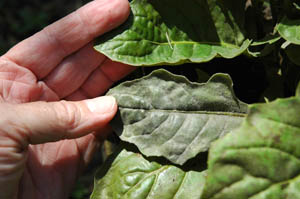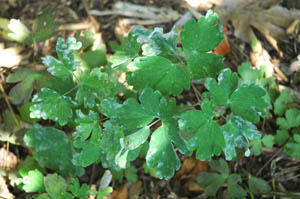Powdery Mildews Must Enjoy This Weather | |
|---|---|
| July 11, 2007 | |
|
Powdery mildew is a fungal disease that appears in warm, humid weather (now). You have probably seen the white, powdery growth on leaves of lilac, zinnia, and hundreds of other landscape plants. The powdery growth is composed of mycelia and spores, and the spores are easily spread throughout the landscape in the wind. The spores germinate on foliage when the relative humidity is 23 to 99% but not in free moisture (rain). Based on weather we have experienced this past week, powdery mildew ought to be thriving soon. Powdery mildew is a common fungal disease problem on many perennials, as well as annuals, shrubs, and even trees and turf. The most common hosts in Illinois seem to be lilac, zinnia, phlox, and rose; but certainly other species are affected. The image shows powery mildew on gerbera daisy (Gerbera). The darker leaf with the white powedery growth is infected, while the green leaf is unaffected.  Powdery mildew is a particular problem on this host. The next image shows powdery mildew on columbine (Aquilegia). Powdery mildew is a particular problem on this host. The next image shows powdery mildew on columbine (Aquilegia). There are many different types of powdery mildew fungi, and most are very host specific. For that reason, we will probably never see an epidemic of this disease in Illinois. Still, on one plant the disease may spread very quickly, especially in humid weather. Despite the fact that this disease does not kill plants, if your zinnias, roses, or other plants are infected, that may be a major aesthetic concern to you. There are many different types of powdery mildew fungi, and most are very host specific. For that reason, we will probably never see an epidemic of this disease in Illinois. Still, on one plant the disease may spread very quickly, especially in humid weather. Despite the fact that this disease does not kill plants, if your zinnias, roses, or other plants are infected, that may be a major aesthetic concern to you.Symptoms of powdery mildew include a white mildew type of growth on leaves, shoots, buds, flowers, or stems. This mildew is composed of threadlike mycelium and asexual spores of the fungus. Spores can be blown to other plant parts and cause further infection. New growth is particularly sensitive. The disease is very obvious, often unsightly. Occasionally, infected foliage exhibits a purple cast rather than a white color, as is true of infected apple or crabapple foliage, as well as strawberry leaves. To avoid problems with powdery mildew, provide conditions for adequate airflow in the planting. This may mean that plants need to be thinned or pruned to allow better air movement. Use recommended mature plant spacings when establishing new plants. Because the pathogen thrives in humid conditions, water the plants early in the day to promote rapid drying. Avoid syringing foliage, and try to water the soil rather than the foliage. Even with these precautions, powdery mildew may be plentiful. Resistant varieties may be the answer. If you have had problems with powdery mildew, look through garden catalogues for resistance to this disease pathogen. Ask for similar information at nurseries. The Internet is also a good reference for such information. Try searching under the host name and the disease name. For example, the Chicago Botanic Garden has a list of 10 Monarda cultivars resistant to powdery mildew. Fungicides can be used to control powdery mildew. Scout for the appearance of the disease and then treat the plants according to label directions. Fungicides are used to fight powdery mildew as preventives. Sprays are used to protect the new growth from infection. Consult the 2007 Commercial Landscape & Turfgrass Pest Management Handbook or the Home, Yard, & Garden Pest Guide for a list of registered fungicides by host and by disease. These manuals are available in local Extension offices. Report on Plant Disease, no. 617, “Powdery Mildews of Ornamentals” is available on the Extension Web site http://www.ag.uiuc.edu/~vista/horticul.htm or in Extension offices and provides detailed information about powdery mildew. |